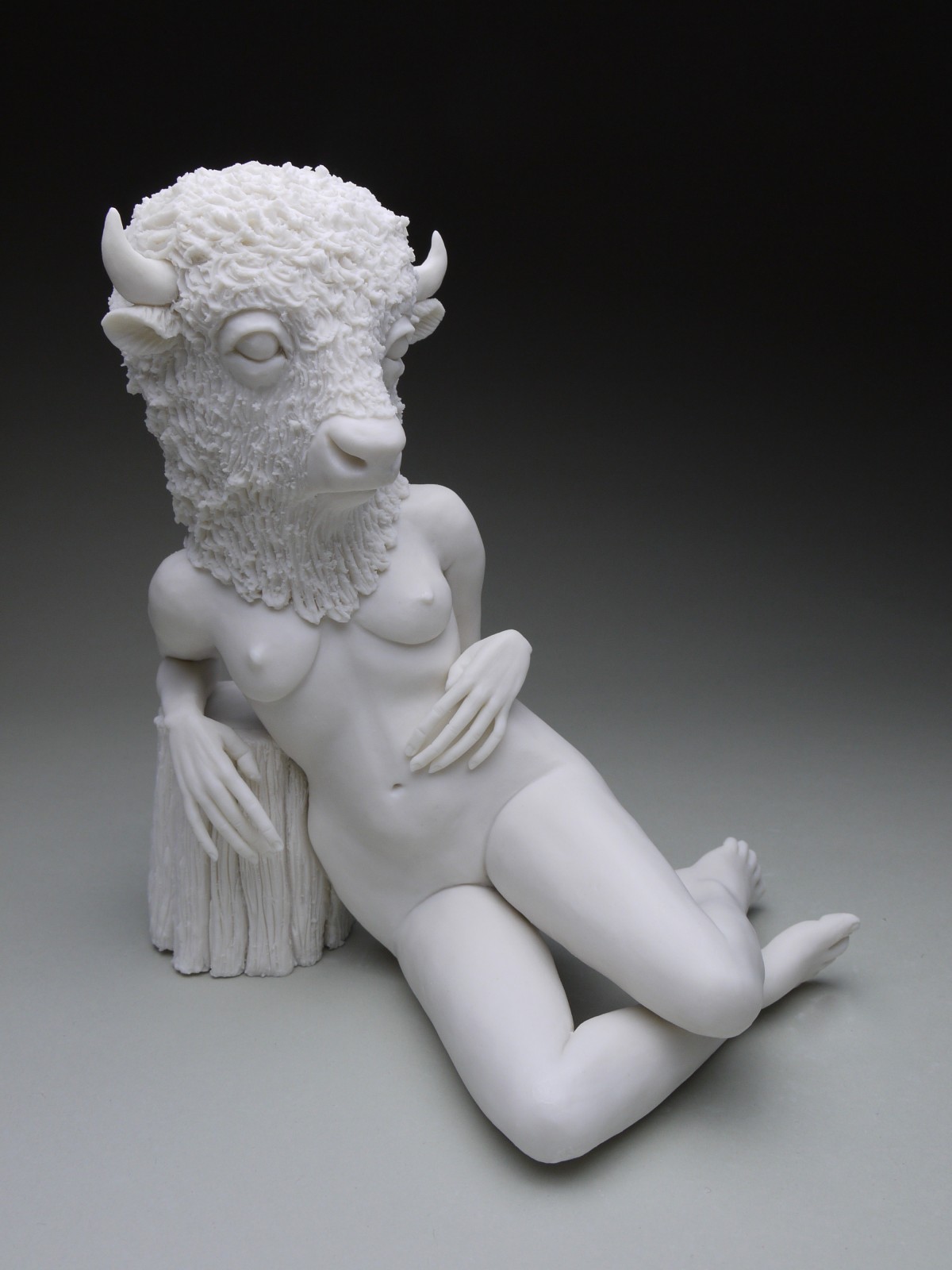Crystal Morey creates a new mythology of the West at Radius Gallery
This month’s show at the Radius Gallery, Compositions, is an incredibly curated collection of work by four artists that creates a space reminiscent of the magical woods in a fairytale. The trees are free-standing sculptures by Trey Hill, washed with layers of thinned underglaze and water that’s been allowed to run and blend in greens and blues. Catherine Earl’s large depictions of geese and foxes make deep shadows even as their forms, in blue-gray washes and light paint splatters, evoke fresh, dense air.
The characters in this storied place are introduced by two artists: Jennifer Eli French of Billings and Crystal Morey of Oakland. French’s dreamlike Renaissance-style portraits of animal-human hybrids are stern but colorful. She plays with images of twins, burning houses, tigers in lady’s gowns and women with Miller moth crowns.
Three enchanting pieces by Morey are set on pedestals around the room. They are visually captivating white porcelain figurines depicting hybrids of human and animal bodies. There’s a bust of a woman with antlers, her delicate face directed to stare into your own. Two female-bodied nudes with long, delicately rendered fingers recline in languid postures, each topped with the full bulk of an oversized animal head: One a bison, the other a fox, whose pointed fur flattens and transforms into light foliage creeping down her belly.
These sculptures are nostalgic of the fantasy novels I buried myself in as a kid in eastern Montana. Talking animals, fairies and fauns—I used to pray to God for a pegasus. These stories captivated me, out there on the dry prairie. Our most interesting wildlife was the invisible bobcat, and, while we regularly rode horses, it was almost always to work cows in the heat of August or dead-cold of winter. I lived for the moment that my dad’s sway-backed bay, Bill, would turn to me and ask my help in his escape.
This yearning dominated my childhood but became tragic when I grew up and realized the effect humans like myself have on real creatures. Morey works to reveal that tragedy by putting endangered animals’ heads on human bodies. “I want us to visualize ourselves as another species and how that would feel,” she says. “If that were the case, would we treat the land around us differently? Would we be more aware of our actions?”
In her early work, Morey concentrated on depicting animals made extinct by human influence since the Industrial Revolution, such as the Western Black Rhino and Baiji river dolphin. Her animal vocabulary has expanded since then, and she now looks more generally at animal species most affected by human activity, even if they aren’t technically endangered.
Her choice to use Western animals in these particular pieces works well to spark that empathy. Because these animals are familiar, the story feels present here, as our dry mountain ranges burn and fill the valley with smoke. Each human body in her sculptures seems like a curse on the animal, posing a narrative in which people like us are made to reckon with the damage we’ve done.
The bison, depicted in her piece, “New Symbiosis: North American Bison,” is a part of the great American mythology; we came, we saw, we took. We gathered our guns and our men killed millions of them, piling their skulls into towering pyramids to plant a booted foot onto and pose, stoney faced, for a photograph.
That animal is more of this land than we are, but seen so rarely it’s almost like a magical beast. The breathless effort to bring the bison back ironically seals the deal that humans continue to be at the helm of their survival. This is the symbiosis in the piece’s title—the strange new relationship between us and the animal world.
Morey says she finds it interesting that nature, and how we relate to it, is depicted consistently throughout art history. Think of deer and stallions in Renaissance paintings, Van Gogh’s trees and even Andy Warhol’s “Silver Clouds.” (Though they were shiny foil, he was thinking of the natural world.)
Crystal Morey’s mythical creatures are quiet and lovely but they resonate in a big way. Compositions centers on a magical universe, but at the heart of it, the pieces force us to think about human nature and reckon with the decisions we have made in the real world.
Compositions continues at the Radius Gallery through September 23.
